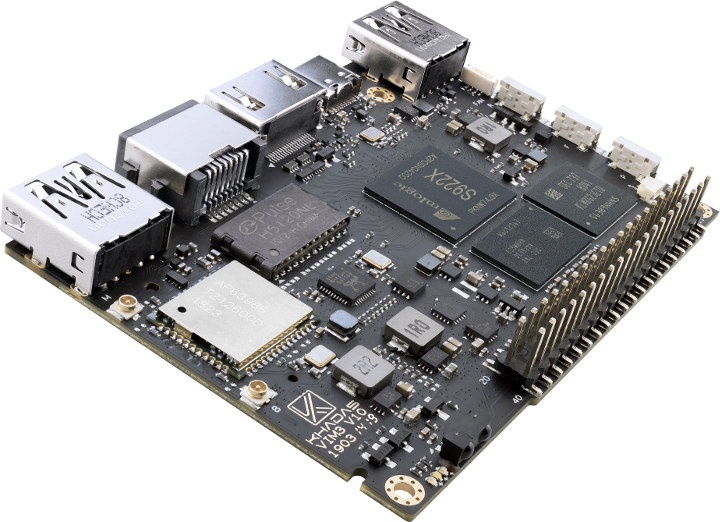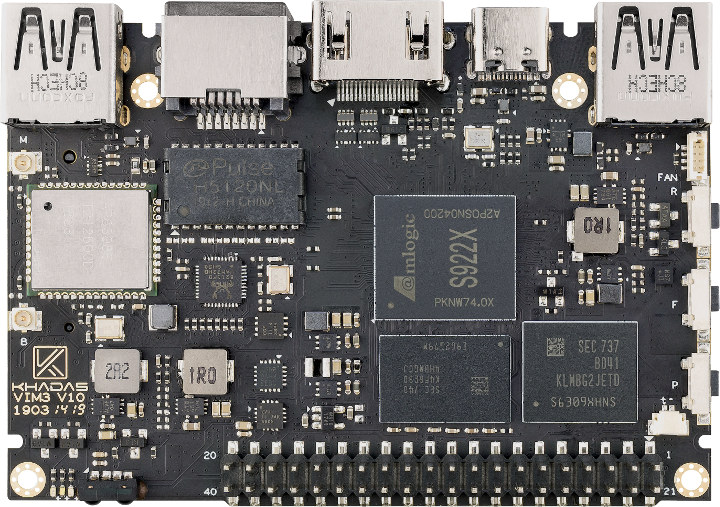Ever since the Amlogic S922X powered ODROID-N2 SBC launched last March, I keep reading praise for the processor and board which both deliver great performance at a relatively low price. Hardkernel was the only company that sold such a board so far, but this is about to change with some competition coming from Shenzhen Wesion with their upcoming Khadas VIM3 board that includes 2 to 4GB RAM, 16 to 32GB eMMC flash storage, a wireless module, support for M.2 NVMe SSD, and more.

Even though more are planned in the future, two Khadas VIM3 models have been announced so far – Basic and Pro – with the following preliminary specifications:
- SoC – Amlogic S922X hexa-core processor with 4x Arm Cortex-A73 and 2x Cortex A53 cores, Arm Mali-G52 MP4 GPU, built-in Cortex-M4 core for “always-on” processing
- MCU – STMicro STM8S003 with Programmable EEPROM for power management, customizations, and boot media configuration
- System Memory & Storage
- VIM3 Basic – 2GB LPDDR4/4X RAM, 16GB eMMC 5.1 flash
- VIM3 Pro – 4GB LPDDR4/4X RAM, 32GB eMMC 5.1 flash
- Common – 16MB SPI flash, microSD card slot supporting up to UHS-I SDR104, support for M.2 2280 NVMe SSD (see Expansion section)
- Video Output & Display Interface
- HDMI2.1 transmitter with 3D, Dynamic HDR, CEC, and HDCP 2.2 support
- 4-lane MIPI-DSI interface up to 1920 x 1080
- 10-pin 0.5mm Pitch FPC Connector for touch panel
- Video
- 4K UHD H.265 75fps 10-bit video decoder & low latency 1080p H.265 / H.264 60fps decoder
- Supports multi-video decoding up to 4Kx2K@60fps + 1x1080P@60fps
- Dolby Vision and HDR10, HDR10+, HLG, and PRIME HDR video processing
- Connectivity
- Gigabit Ethernet with WoL support
- 802.11a/b/g/n/ac WiFI 5, 2X2 MIMO with RSDB and Bluetooth 5.0 via Ampak AP6398S module
- USB – 1x USB 3.0/2.0 type A port, 1x USB 2.0 type A port, 1x USB 2.0 OTG type-C port with USB PD support
- Sensor – KXTJ3-1057 3-axis digital accelerometer
- Expansion
- M.2 Socket with single lane PCIe 2.0, USB 2.0, I2S, I2C, ADC, 100M Ethernet PHY interface, GPIO, MCU_PA2
- 40-pins 2.54mm pitch header exposing:
- CPU signals – USB, I2C, I2S, SPDIF, UART, PWM, ADC
- MCU signals – SWIM, NRST, PA1
- Misc – 2x IR receivers, RTC & battery header, 4-pin cooling fan header with PWM speed control, 3x LED’s, power, Func and reset buttons, XPWR pads for an external power button
- Power Supply – 5V to 20V via USB-C port or pogo pads
- Dimensions – 82.0 x 58.0 x 11.5 mm (4x M2 mounting holes)
- Weight – Around 30 grams
- Certifications – CE, RoHS

Khadas VIM3 comes with some extra features compared to ODROID-N2 including built-in eMMC storage (instead of external flash), an M.2 socket supporting NVMe SSD, built-in WiFi and Bluetooth, a MIPI-DSI connector, and a few other features like an accelerometer and larger SPI flash. VIM3 is also quite smaller compared to ODROID-N2.
The company did not expand on software support at this stage, except they will provide Fenix Script, a “one-click” script for building Linux distributions.
Khadas VIM3 is coming soon, but pricing has not been announced yet. One thing for sure is that it will be more expensive than the $63/$79 ODROID-N2 simply because of the extra features such as built-in storage which you need to purchase separately for the Hardkernel board. More details may be found in the “launch page“. It’s very likely an Amlogic S922D version will be launched as well, since the company mentions “next generation, deep-neural-network applications, at 2.5 TOPS“.

Jean-Luc started CNX Software in 2010 as a part-time endeavor, before quitting his job as a software engineering manager, and starting to write daily news, and reviews full time later in 2011.
Support CNX Software! Donate via cryptocurrencies, become a Patron on Patreon, or purchase goods on Amazon or Aliexpress




